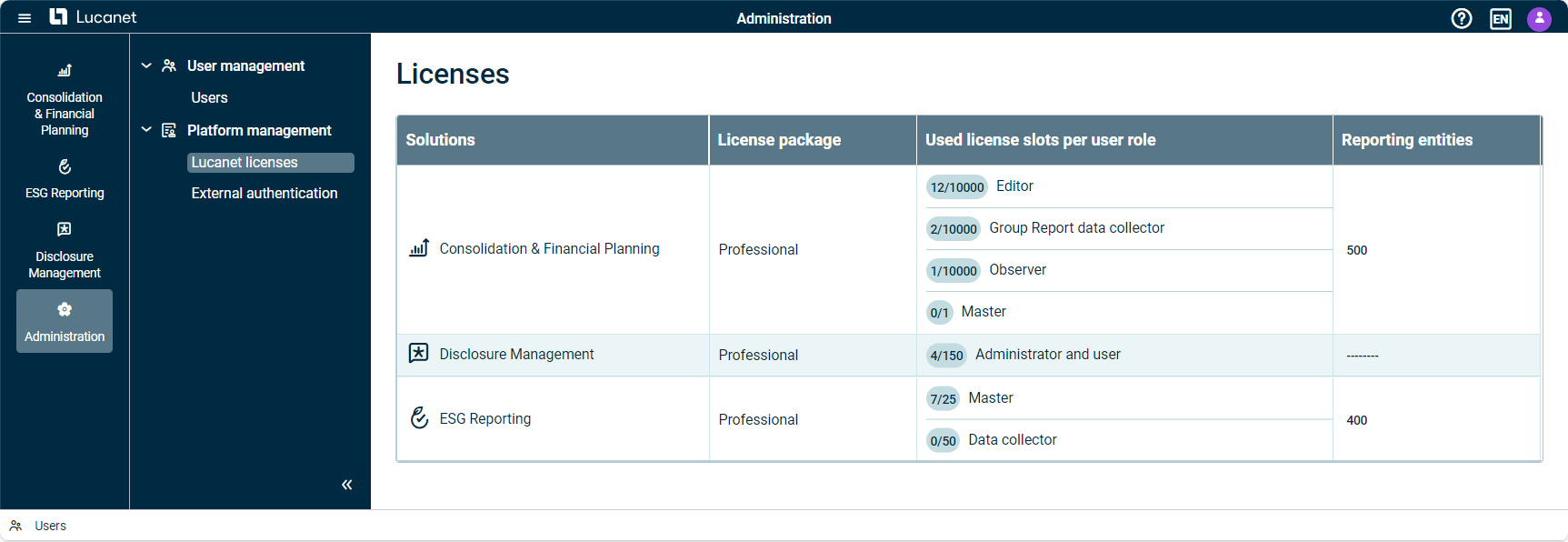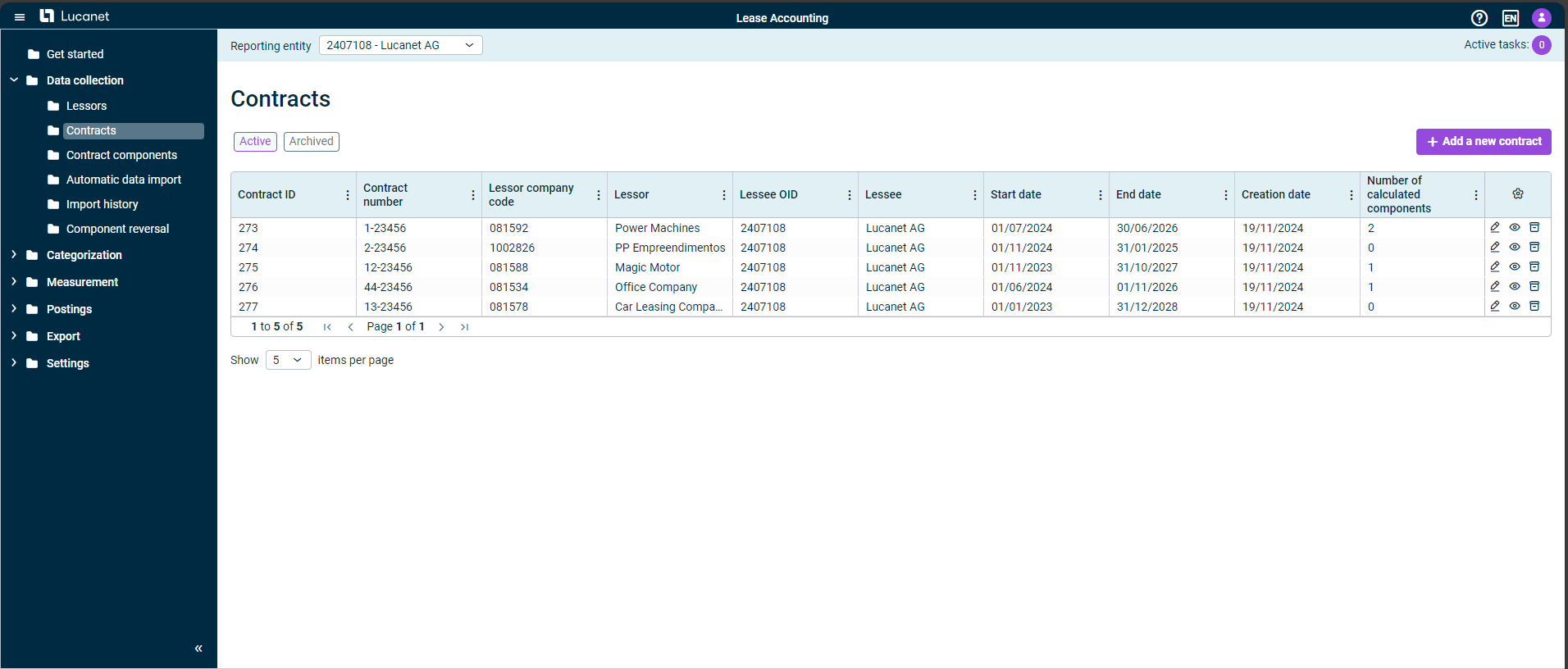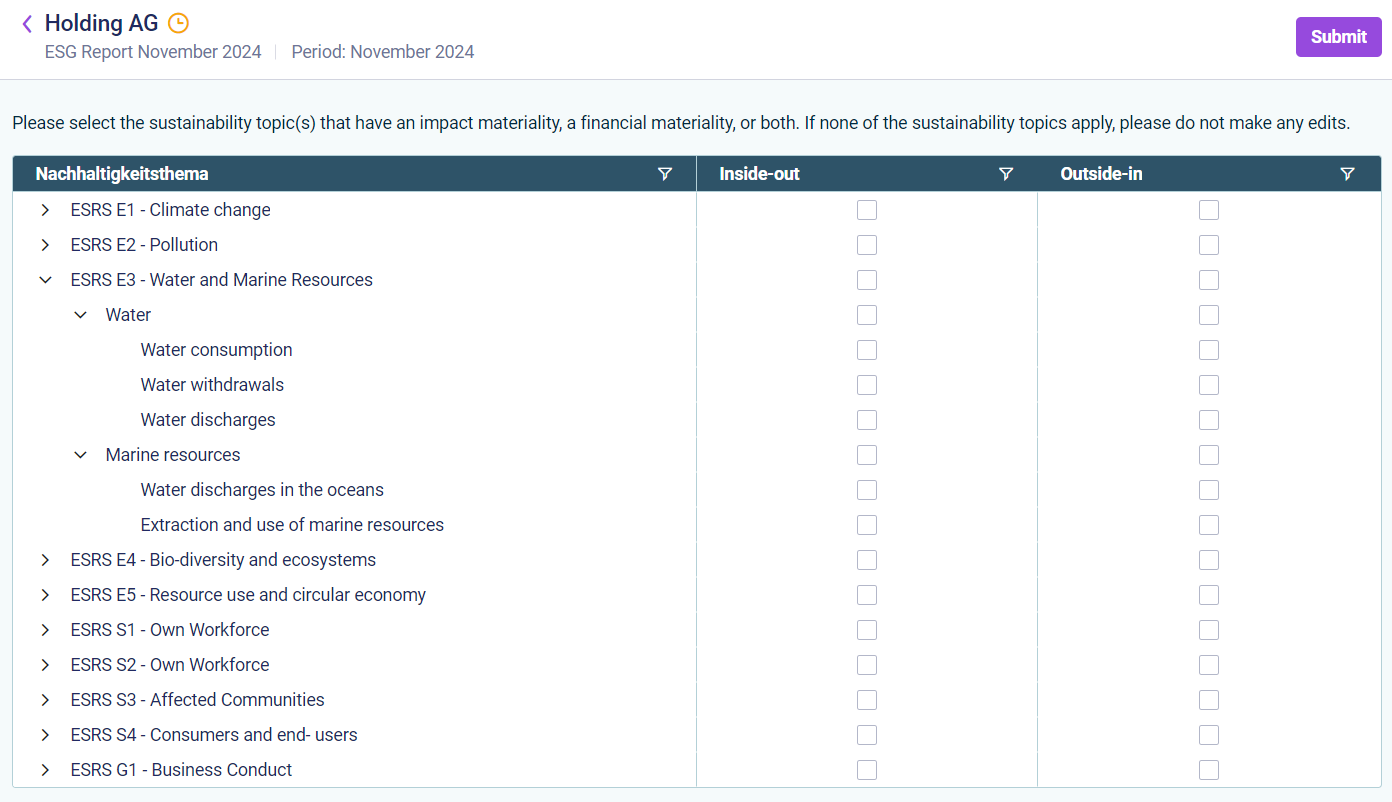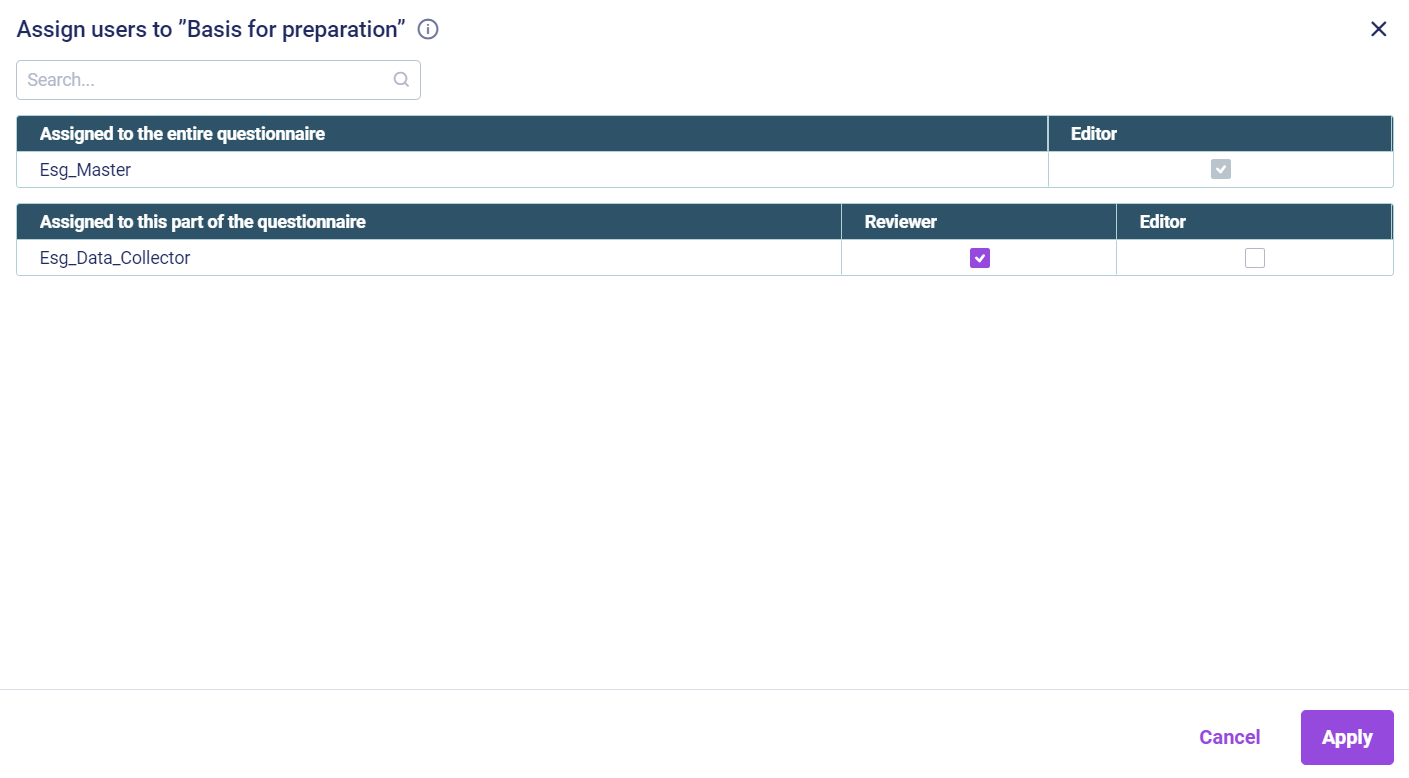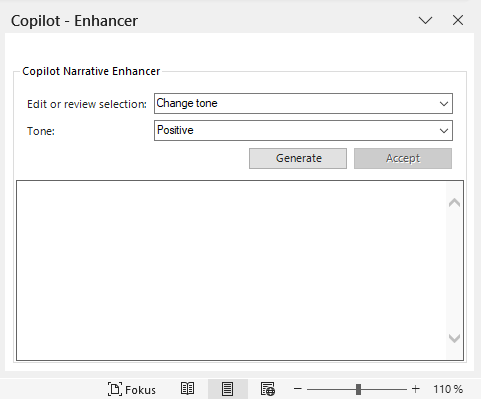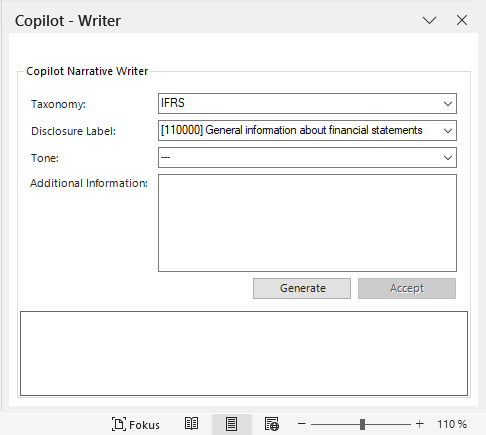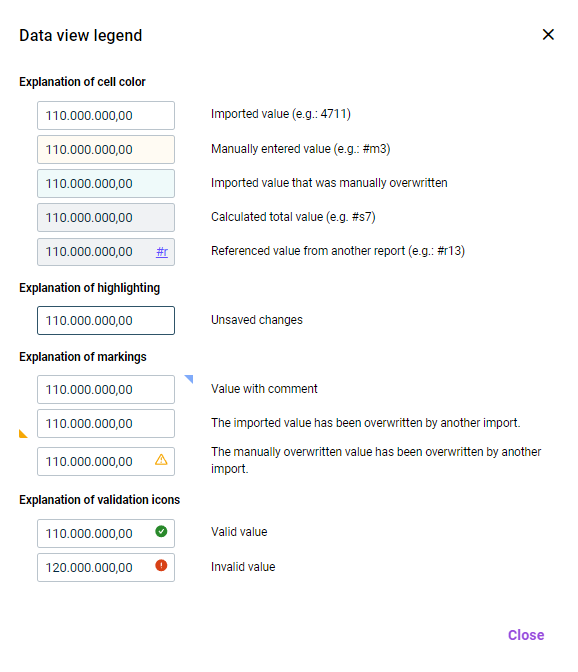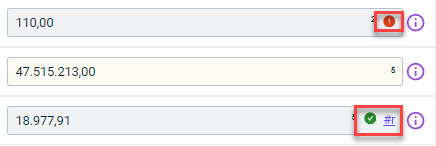What's New in Lucanet 25?
Come and explore the exciting new features of our latest release! The following new features for the Lucanet CFO Solution Platform have been released since Lucanet 24.1:
Our Highlights
- CFO Solution Platform
- Lease Accounting
- ESG Reporting
- Consolidation & Financial Planning
- Disclosure Management
New in Version 1.6 (Release Date 2025-01-27)
Apart from bug fixes and performance enhancements, the release contains the following new features:
Simultaneous User Account Management
User management has been enhanced to enable simultaneous management of multiple users, making administrative tasks easier and more efficient. In the list of users, you can now select multiple users and perform the following actions:
- Edit users with the following options:
- Change user access and user roles
- Enable or disable external authentication
- Lock or unlock users
- Change language and formatting settings, if these settings have not been changed by the user
- Resend invitation e-mail
- Delete users
Extended Version Information in the 'About Lucanet' Menu
Our new solutions, Lucanet XBRL Tagger and Lucanet Lease Accounting, are now available in the Lucanet CFO Solution Platform. In the About Lucanet menu you can also view the current versions of XBRL Tagger, XBRL Engine, and Lease Accounting. This gives you a complete overview and makes it easier to track updates.
New in Version 1.5 (Release Date 2024-11-28)
Apart from bug fixes and performance enhancements, the release contains the following new features:
Change Log in User Management
The new change log in the user management allows you to efficiently monitor and manage all changes made to your users. You can display a user's change log or an overview of all user changes.
In the change log table, you will find detailed information about the changes made. This includes the date of the change, who performed the change, the action, the impacted user (in the general change log only), the exact change, and the old and new values of the changed settings. The general change log is displayed as follows, for example:
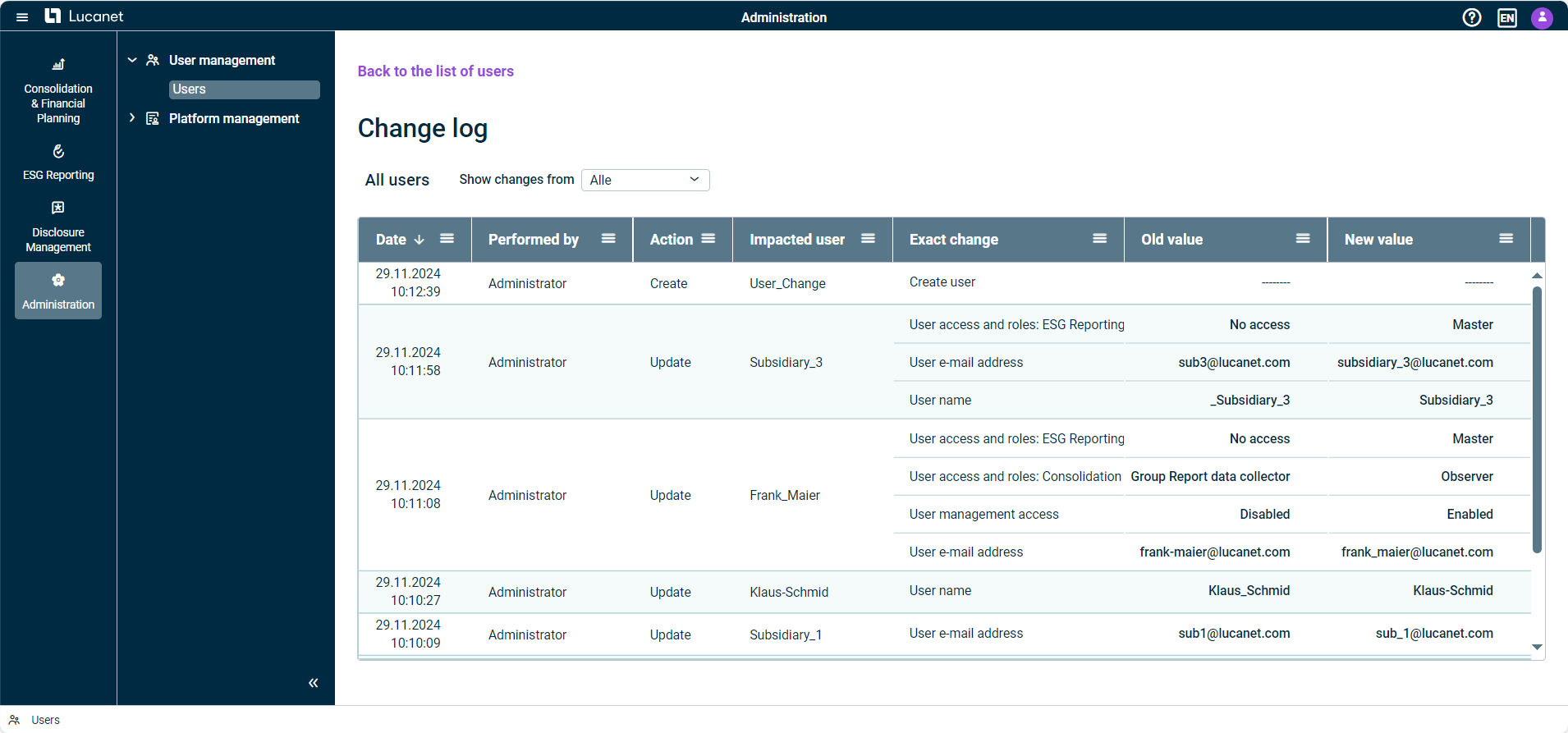 General change log in user management
General change log in user management
You can set the desired time period for the display of changes and sort the data by date of change or filter the data according to specific criteria in order to find the desired information more quickly.
New in Version 1.4 (Release Date 2024-10-31)
Unified Login Page for Lucanet.Financial Client
As a user of the Lucanet CFO Solution Platform, if you have access to Lucanet.Financial Client, you can now log in to Lucanet.Financial Client using the same login page as for the Lucanet CFO Solution Platform. You can either log in with your Lucanet credentials or via SSO, if external authentication is enabled for your Lucanet CFO Solution Platform account. This new feature provides a seamless user experience when logging in and streamlines access to your Lucanet services.
UX and Usability Improvements in Administration
In Lucanet 25, we have introduced a number of updates to the Administration section that are designed to improve the user experience and increase user-friendliness. Some of the main improvements are:
- Navigation improvements in the list of users: By using infinite scrolling, administrators can now better navigate the list of users by first displaying 20 users and then loading more by scrolling as needed. By default, the most recently updated users appear at the top of the list.
- Moving user configuration to the right side panel: Administrators of the Lucanet CFO Solution Platform can now use the right side panel to create or update users. The side panel replaces the previous dialog and offers the same fields, input requirements, and validation checks. This allows an intuitive and efficient configuration of all necessary user settings.
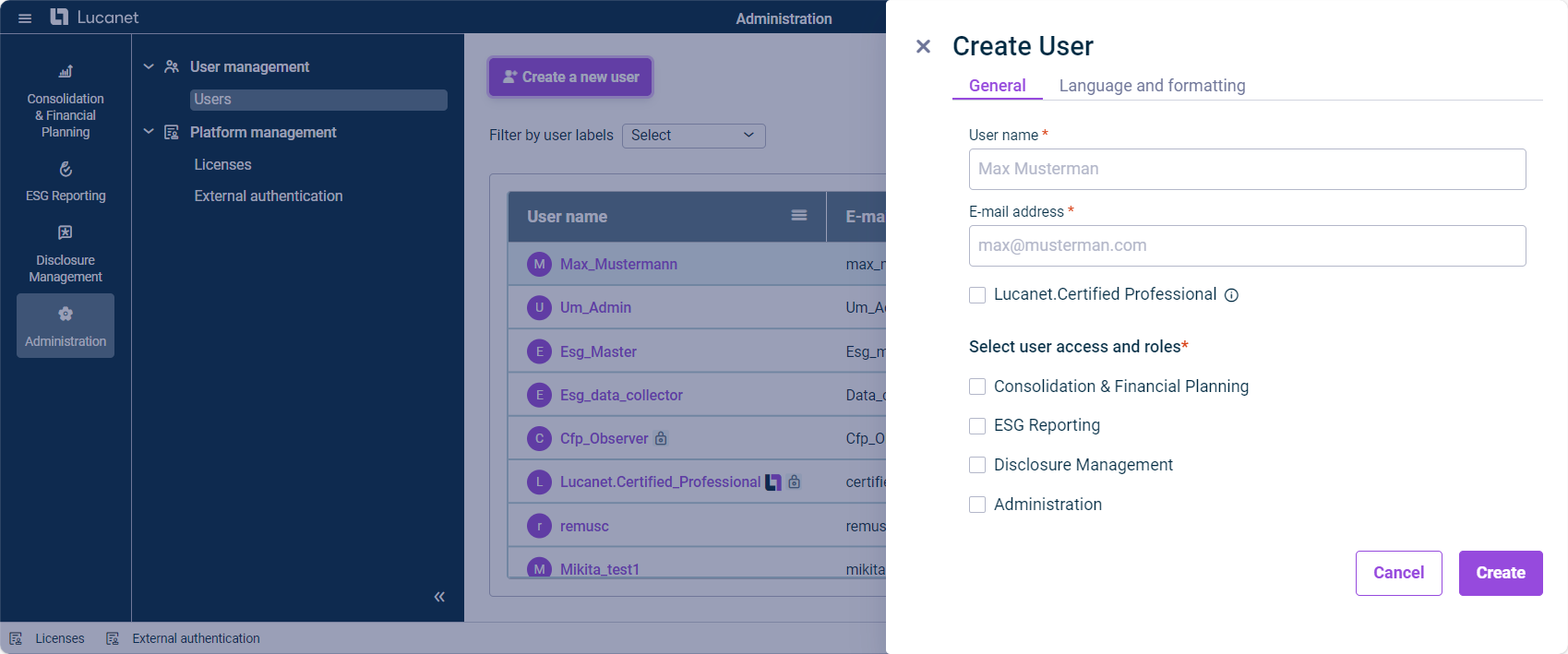 Side panel for creating users
Side panel for creating users
- Optimization of the license display: Lucanet 25 offers you as administrator an improved overview of your license information. The table in the Licenses workspace shows the used and available license slots per user role for each solution, whereby user roles with 100,000 or more license slots are marked with the infinity symbol (∞). In addition, the user roles are listed on separate lines for a better overview. The workspace Licenses, is displayed as follows, for example:
New in Version 1.3 (Release Date 2024-09-24)
Apart from bug fixes and performance enhancements, the release contains the following new features:
Enhancement of the Login Options: New Workspace 'External Authentication'
From now on, administrators of the Lucanet CFO Solution Platform can configure and enable an External Identity Provider in the External Authentication workspace. The following authentication protocols are available: OIDC and SAML.
The External authentication workspace is displayed as follows, for example:
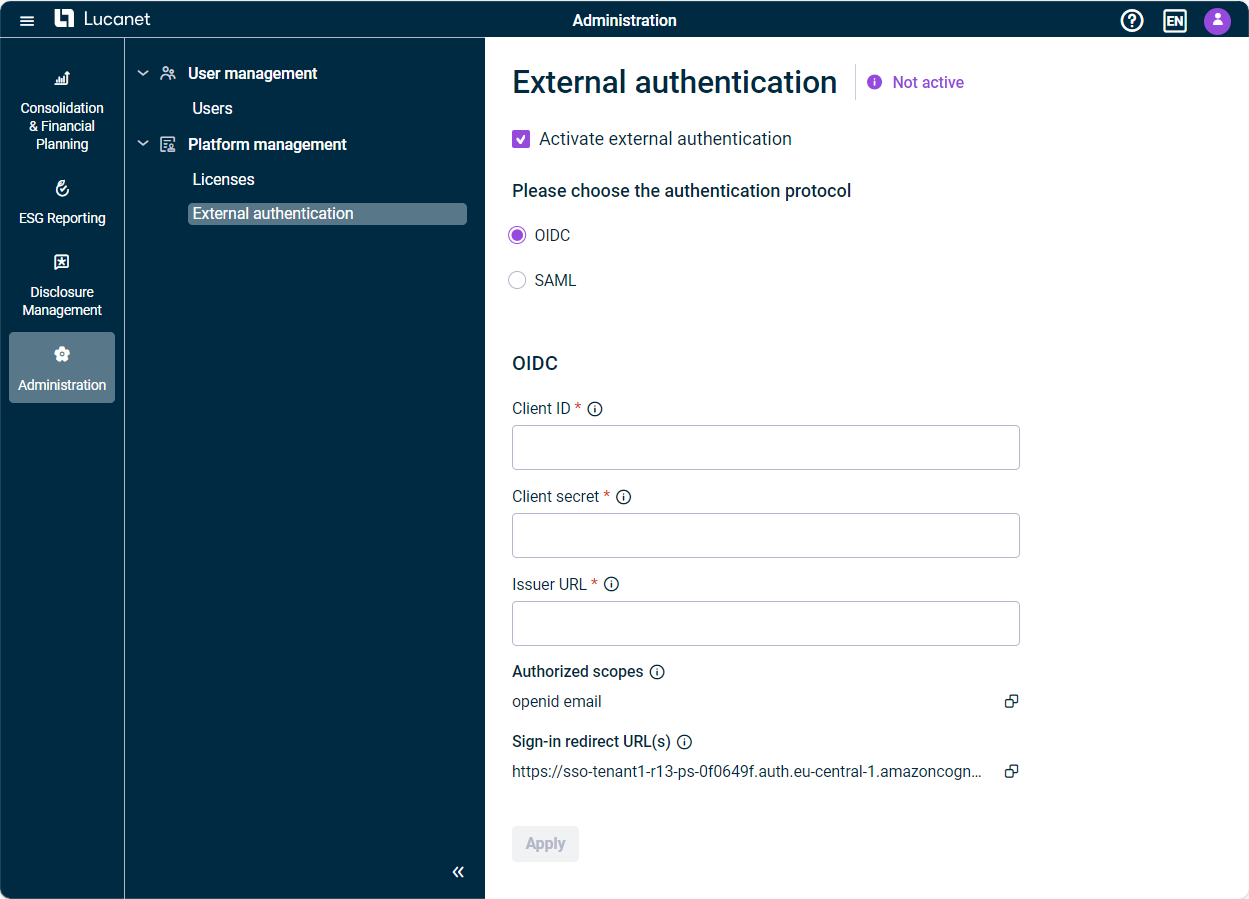 The ‘External authentication’ workspace
The ‘External authentication’ workspace
If external authentication is activated, the Enable external authentication option is available when creating or editing a user. If external authentication is not activated within the External Authentication workspace, the option to Enable external authentication will not be visible for the administrator when creating or editing a user. Thus, the users will continue to log in with their Lucanet credentials.
This enhancement allows for more flexibility and security when logging in, improves the user experience, and enables seamless integration into our customers' existing IT infrastructure.
Improved User Management Efficiency: New Labels And Filter Options for Special User Groups
In version 1.3, we have further optimized the user management. Administrators of the Lucanet CFO Solution Platform can now identify and manage users more quickly using the following labels:
| Label | Users |
|---|---|
| Lucanet.Certified Professional users | |
| Permanently locked users | |
| Users for whom external authentication is activated |
As soon as one of these options is configured for a new or existing user, the label appears after the user name in the list of users. If you hover over the label, a tooltip displays the corresponding information.
In addition, a new filter above the list of users enables a targeted search and quick display of the three user groups.
No More Licenses Needed for Lucanet.Certified Professional Users
With the new release, Lucanet.Certified Professional users no longer require license slots. This allows Lucanet.Certified Professional users to be assigned roles in a licensed solution even when there are no more license slots available.
Release of Lucanet Lease Accounting (Release Date: 2024-12-18)
The new Lucanet Lease Accounting solution is now available on our Lucanet CFO Solution Platform!
Use this secure and efficient solution to enter, calculate and post Lease Contracts in accordance with IFRS 16 to ensure that your accounts are correct and comply with all the necessary regulations.
Lease Accounting offers you:
- Simple and intuitive operation: When you enter a lease contract, the software will actively guide you through the relevant contract dialogs.
- Contract simulation: Generate previews of the calculations for your most important lease contracts and check your data.
- Fast exports: With just a few clicks, you can export the postings you have created in Lease Accounting to MS Excel, or generate reports for all the contracts or balances you have created for a set reporting date.
New in Version 1.6 (Release Date 2025-02-03)
Attached Files Can Be Deleted
In the ESRS questionnaire, you can attach files to certain questions to provide further information or evidence for your data input. As of now, it is also possible to delete attached files, if necessary.
For more information, see Editing Data.
Activating the Double Materiality Assessment When Building the Questionnaire
In case you have deactivated the Double Materiality Assessments option in the master data page and have moved to the questionnaire builder, you can still return to the master data page and activate this option if the double materiality assessment becomes necessary. By doing so, the status of your ESG report will automatically set to Double Materiality Assessments and all the changes that you have made to the ESRS questionnaire will be discarded.
For more information, see Using the Questionnaire Builder.
Canceled ESG Reports with Double Materiality Assessment in Progress
As of now, you can access the list of canceled ESG reports that had a double materiality assessment (in progress or finalized). To access the list, navigate to the Double Materiality Assessment workspace and click the Canceled reports tab:
New in Version 1.5 (Release Date 2024-12-18)
Introduction of Double Materiality Assessment
Lucanet ESG Reporting now includes the option to include the double materiality assessment as an essential first step in determining the scope of the ESRS questionnaire. If the Double Materiality Assessments option is activated, all reporting entities defined in the master data administration have access to the list of sustainability topics that are relevant to determine the double materiality assessment. The reporting entities are then required to determine whether the sustainability topics have an impact materiality, a financial materiality, or both. This evaluation will automatically be applied to the configuration of the ESRS questionnaire, thereby helping to create a more focused and customized ESRS questionnaire.
For more information, see Performing Double Materiality Assessment.
Review Process for Data Collection
To ensure that accurate answers are provided, ESG Masters can now assign different users to act as reviewers of the answers provided by the editors. Reviewers usually are subject matter experts and confirm the accuracy of the data provided by the editors, or challenge the accuracy of the provided data. Reviewers can be assigned to any level of the ESRS questionnaire during data collection. An ESG report can only be submitted when all answers to which a reviewer has been assigned are marked as Reviewed.
For more information, see Reviewing Data.
Import of ESG Report Data into Lucanet.Financial OLAP Server
Data from an ESG report can now be imported into Lucanet.Financial OLAP Server using the ETL script Lucanet ESG #3679-ESG-STR.CSV.FOS. The ESG report can be in any status. After the data import, the data can be viewed in Lucanet.Financial Client in a statistical ledger in a hierarchy structure. The ESG data can then be used for consolidation and planning purposes and integrated in Lucanet Disclosure Management. If you would like to use this ETL script, contact your Lucanet contact person or contact Lucanet at Contact.
To access the documentation, please start Lucanet.Financial Client and open the online help by clicking the ? menu. The documentation can be found under Lucanet apps | Apps for data transfer (ETL) | _L | Lucanet ESG #3679-ESG-STR.CSV.FOS.
New in Version 1.4 (Release Date 2024-11-04)
Assigning Reporting Entities to Specific ESRS Questionnaire Sections
When configuring the ESRS questionnaire, an ESG Master can now assign specific reporting entities to particular sections within the questionnaire hierarchy for editing, such as a category or a question, or unassign these reporting entities accordingly. This feature allows the ESG Master to have more granular control and also allows for a more flexible data collection process, e.g.
- To ensure that data that only needs to be collected for one reporting entity or on group level can only be assigned to these specific reporting entities.
- To enable data collection on location level.
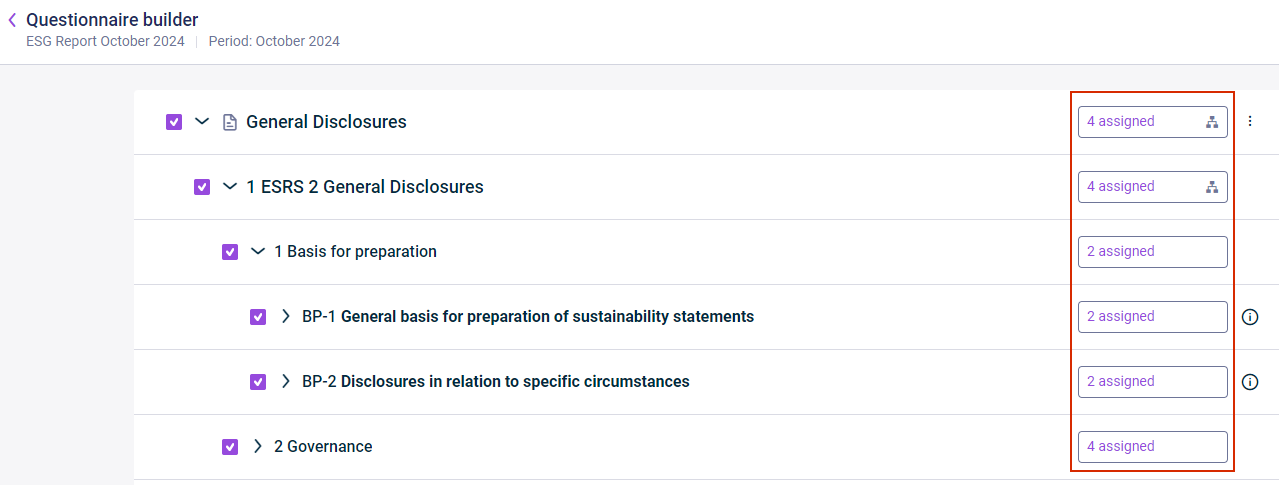 Questionnaire builder with assignment state per element
Questionnaire builder with assignment state per element
For more information, see Configuring the ESRS Questionnaire.
Assigning Users to Specific ESRS Questionnaire Sections
In addition to the possibility to assign reporting entities to particular sections when configuring the questionnaire, an ESG Master can also assign individual users with the user role ESG Data Collector to certain parts of the ESRS questionnaire in the data collection step. This possibility to assign ESG Data Collectors to e.g. categories or guidelines allows for a more focused data collection process and a better alignment with individual enterprise structures. For example, the main responsible person for a reporting entity, i.e. the user assigned to a reporting entity in the master data, can delegate specific questions of the ESRS questionnaire to subject matter experts within their enterprise.
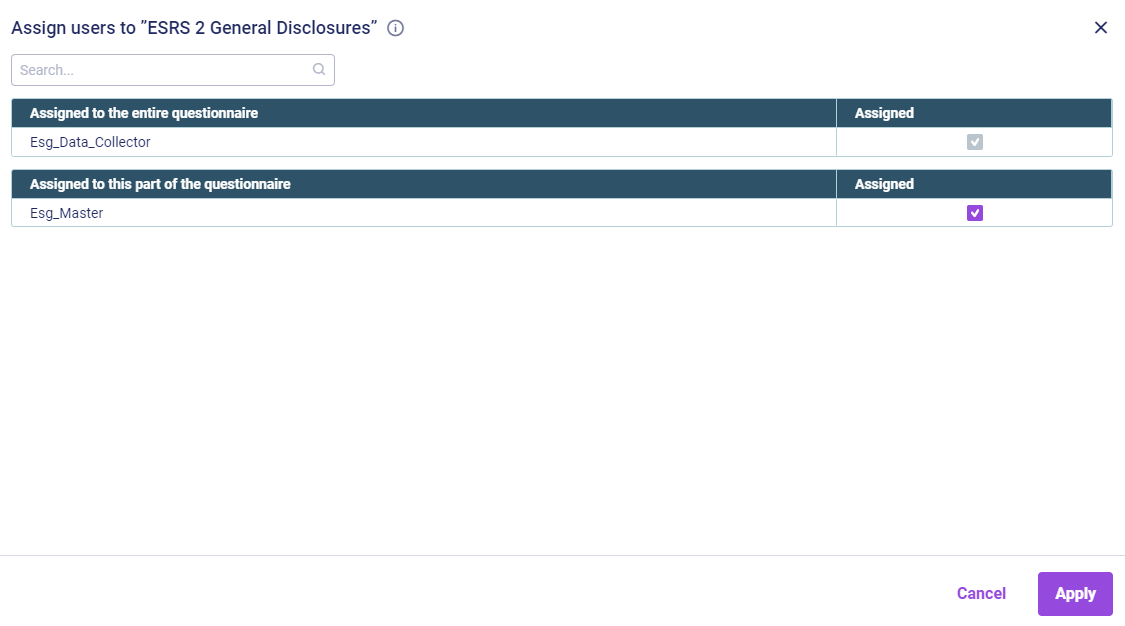 Assigning users to 'Basis for preparation'
Assigning users to 'Basis for preparation'
For more information, see Defining Individual Access for Users.
Duplicating ESG Reports
An ESG Master can duplicate ESG reports by cloning an existing ESG report without the collected data. This way, the ESG Master does not have to create all the reporting entities and users again. The ESG Master can then adjust the report name, date, reporting entity selections, users, locations, and group currencies. This will enable comparisons and highlight changes.
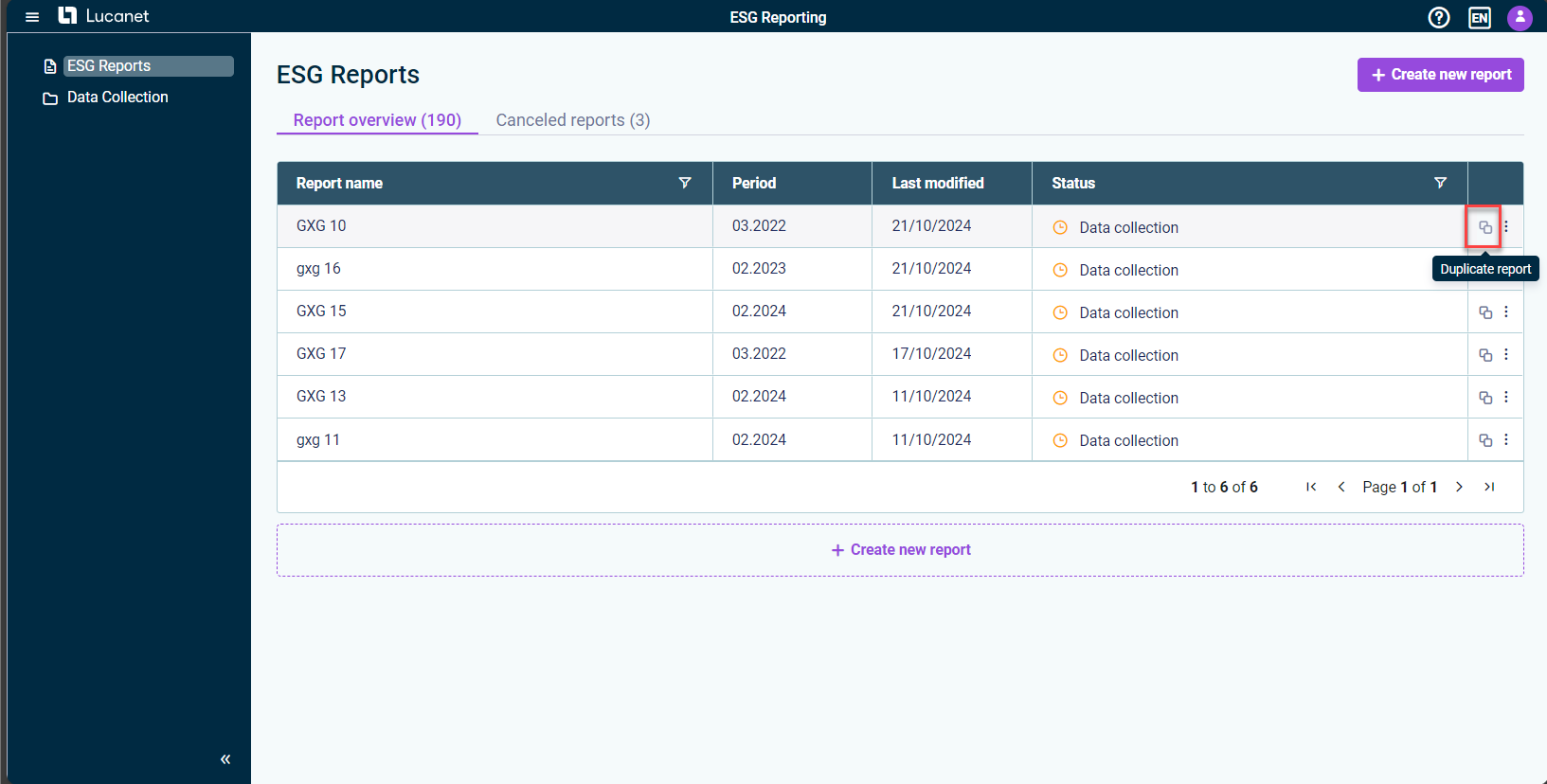 Duplicating an ESG Report
Duplicating an ESG Report
For more information, see General Functions in ESG Reporting.
Attaching Files in ESRS
Users can now attach files within the ESRS questionnaire. This feature will enable all users to upload supporting documents, such as details about their electricity provider. By providing additional information, users will enhance the evidence for the input data.
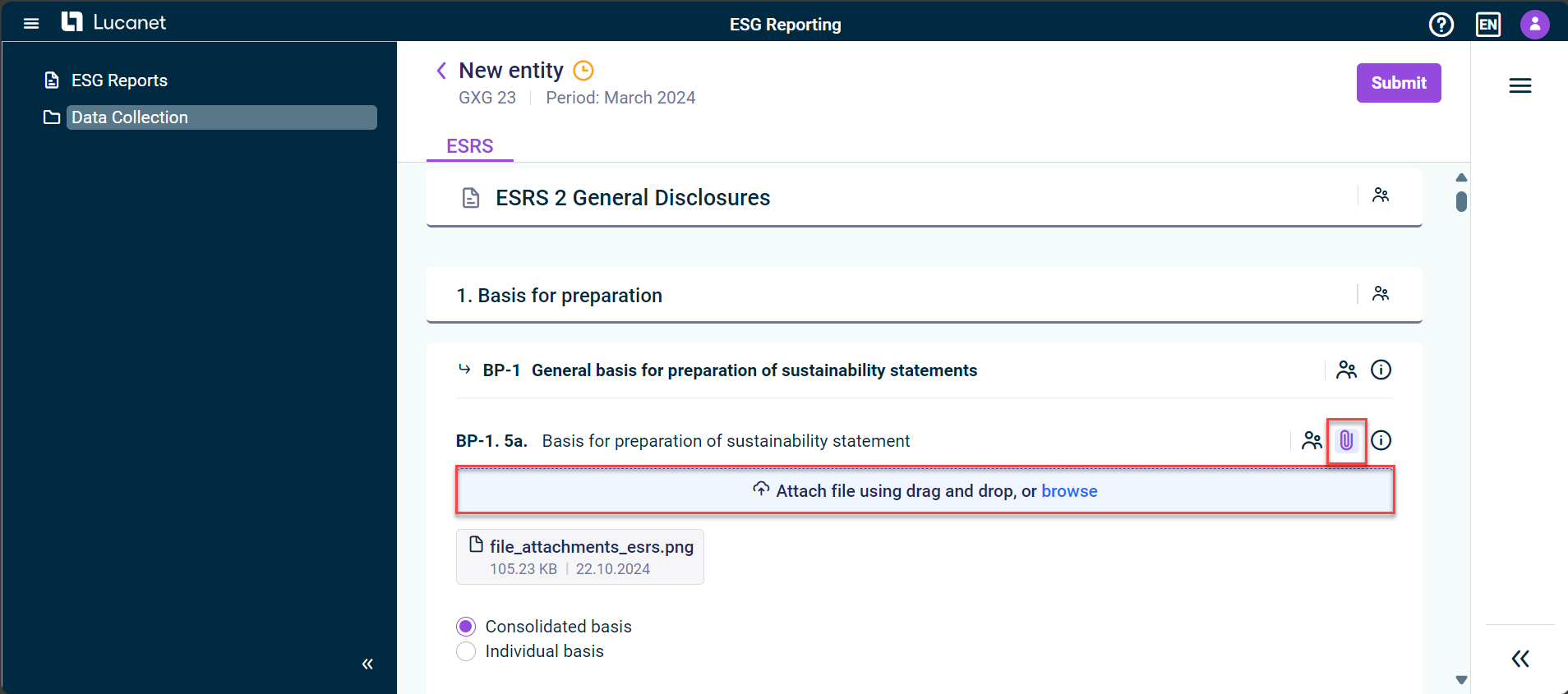 Attaching files in ESRS
Attaching files in ESRS
For more information, see Collecting Data.
Displaying Aggregated Responses During Data Collection
An ESG Master can display the aggregated data of all reporting entities during data collection. This will allow for real-time aggregation of data without delays.
With this functionality, the ESG Master will be able to see details on individual questions, including how many reporting entities have answered or have not answered yet.
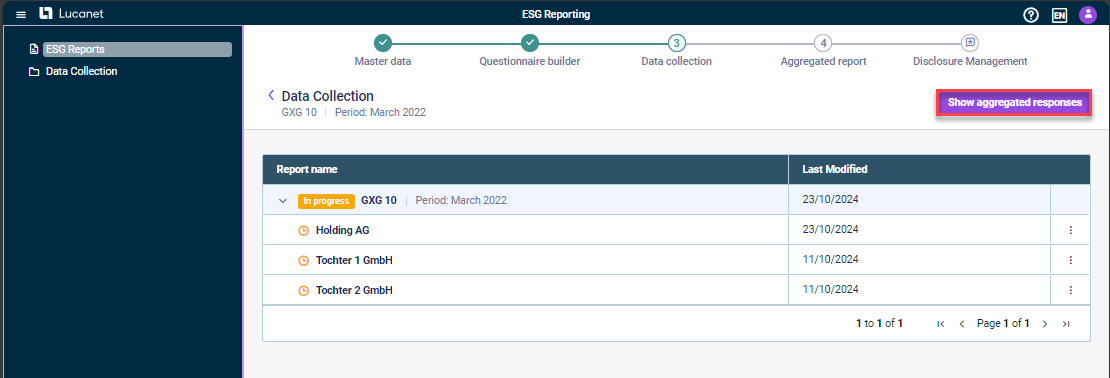
For more information, see Displaying Aggregated Responses During Data Collection.
Enhancements to the Data Collection Step
The data collection has been enhanced as follows to comply with the ESRS XBRL taxonomy:
- Many of the previously existing free-text input fields have been replaced by drop-down lists in the ESRS questionnaire. The values in the drop-down lists are based on predefined values from the ESRS XBRL taxonomy to make data entry more consistent and more standardized.
- Questions that are to be answered with a radiobutton (YES/NO) now have a description field where ESG Data Collectors can provide explanations for the answers they have given.
 Text field for YES/NO answers
Text field for YES/NO answers
Filter Options in the ESG Reports Workspace
New filter options have been implemented for the tabs Report overview and Canceled reports in the columns Report name and Status. The filter option facilitates the search for specific reports or for all reports in a specific status, e.g. reports in the data collection step.
 Filter options in the 'ESG Reports' workspace
Filter options in the 'ESG Reports' workspace
For more information, see General Functions in ESG Reporting.
New in Version 1.3 (Release Date 2024-08-19)
Apart from bug fixes and performance enhancements, the release contains the following new features:
Restoring Canceled ESG Reports
A master user can now restore ESG reports that were canceled previously. If a canceled ESG report is restored, the status of the ESG report is automatically set to the one the ESG report had before it was canceled.
All reporting entities that were assigned before cancellation will be assigned to the ESG report again.
 Restoring an ESG Report
Restoring an ESG Report
For more information, see Functions for ESG Masters in General Functions in ESG Reporting.
Opening Canceled ESG Reports
ESG Masters and ESG Data Collectors can now open canceled ESG reports at the last status of the report. Canceled reports can be opened in the ESG Reports workspace on the Cancelled reports tab:
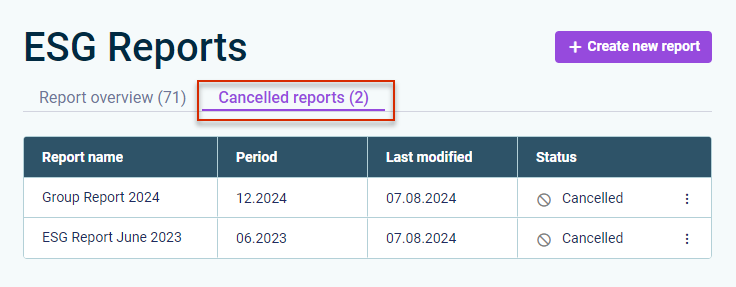 Open cancelled reports
Open cancelled reports
A canceled report is displayed in the step that it was in when it was canceled. If the report was canceled e.g. in the step Questionnaire builder, it will also be opened in the step Questionnaire builder. If a canceled report is opened, it is displayed in read-only mode. For more information, see General Functions in ESG Reporting.
Reopening Aggregated ESG Reports
Once the Data aggregation step has been finalized, an ESG master can reopen the aggregated ESG report to collect updated values from the assigned reporting entities.
An aggregated report can be reopened from:
- The Data aggregation page

Reopening an aggregated report from the 'Data aggregation' page - The report overview in the ESG Reports workspace

Reopening an aggregated report from the 'ESG Reports' workspace
When an aggregated ESG report is reopened, its status as well as the report statuses of the individual reporting entities will be set to In Progress and ESG data collectors can edit the values on the ESRS questionnaire and submit the ESG report again. For more information, see Reopening an Aggregated ESG Report.
Enhancements in the Master Data Administration
When creating an ESG report, the ESG master assigns reporting entities that are part of the data collection. As of now:
- It is possible to search for reporting entities in the list of assigned reporting entities.
- Users who do not have a license for Lucanet.Financial OLAP Server can now manage their reporting entities, i.e. they can delete or rename their reporting entities.
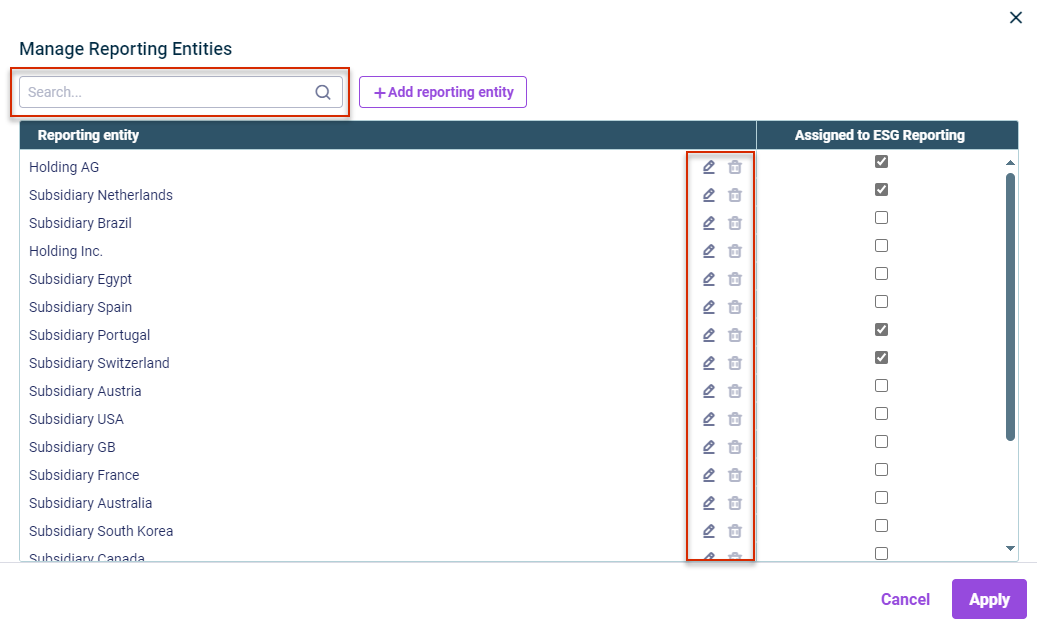 New functionalities for users who do not use Lucanet.Financial OLAP Server
New functionalities for users who do not use Lucanet.Financial OLAP Server
For more information, see Creating an ESG Report.
Enhancements for the Configuration of the ESRS Questionnaire
The configuration of the ESRS questionnaire has been revised. As of now, the questionnaire is displayed in a tree structure to make it easier to recognize which elements (e.g. guidelines, topics, or questions) belong to which superordinate element and the current position of the user in the hierarchy. The various levels can be shown or collapsed individually or completely.
The ESG master can include or exclude various levels of the hierarchy structure from the ESRS questionnaire via a checkbox to show or hide an element in the ESRS questionnaire, i.e. a category, a guideline, a topic, a sub-topic, or a question.
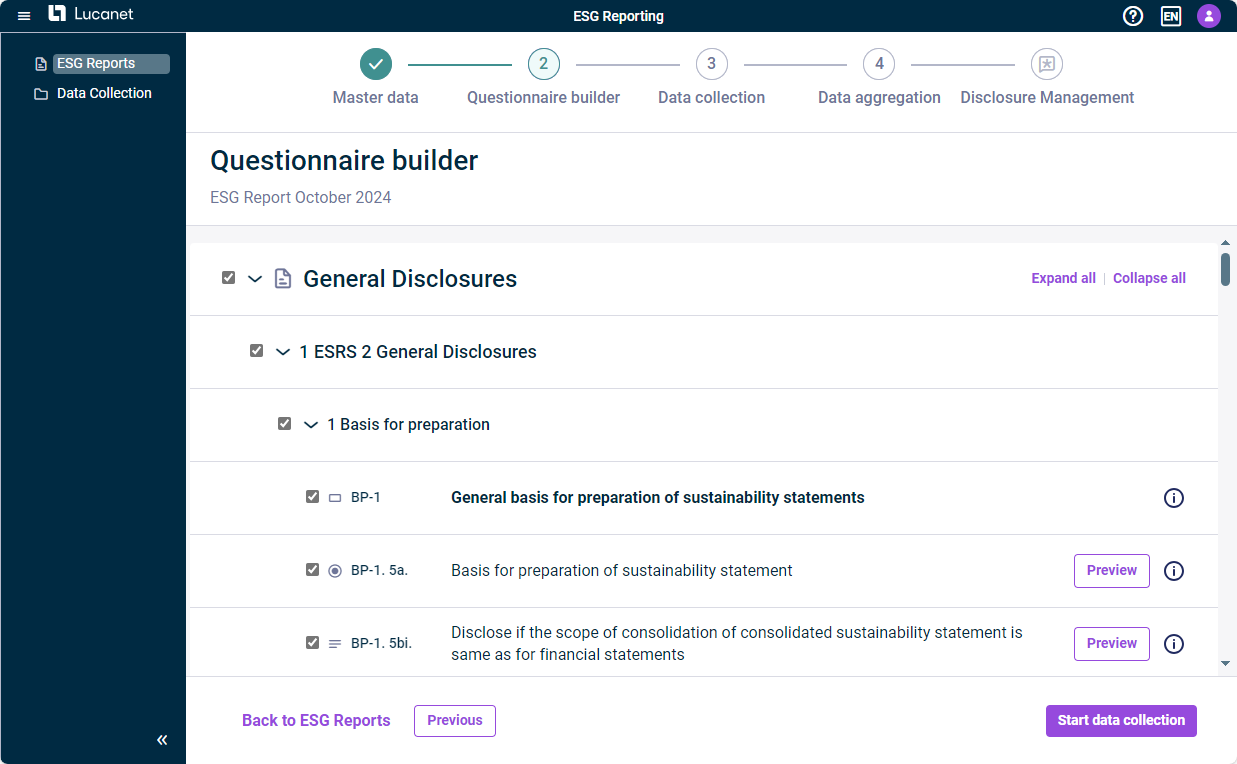 Questionnaire Builder
Questionnaire Builder
An ESG master can also display all questions in the new preview mode to get an impression how the question type and the format for the answers are displayed for the ESG data collectors. For more information, see Configuring the ESRS Questionnaire.
Enhancements for the Data Collection
There have been several user interface improvements to enhance clarity as well as the navigation. You can now benefit from the following:
All actions that are available to you depending on your user role and on the data collection step are now available in an additional column in the ESG Reports and Data collection workspaces, e.g. to show notes or the option to submit or approve an ESG report.
The data collection details of a specific reporting entity are now displayed on a single page instead of one page for ESRS and one page for the emissions module. For easier data collection and data review and a better navigation within the page, the ESRS questionnaire and emissions module are displayed as tabs.
In the ESRS questionnaire and emissions module, it is possible to collapse the panel on the right-hand side of the screen to gain more space for data collection or review.
As an ESG data collector, you can now submit your data or, as an ESG master, you can approve or reject data directly in the data collection page of a single reporting entity.
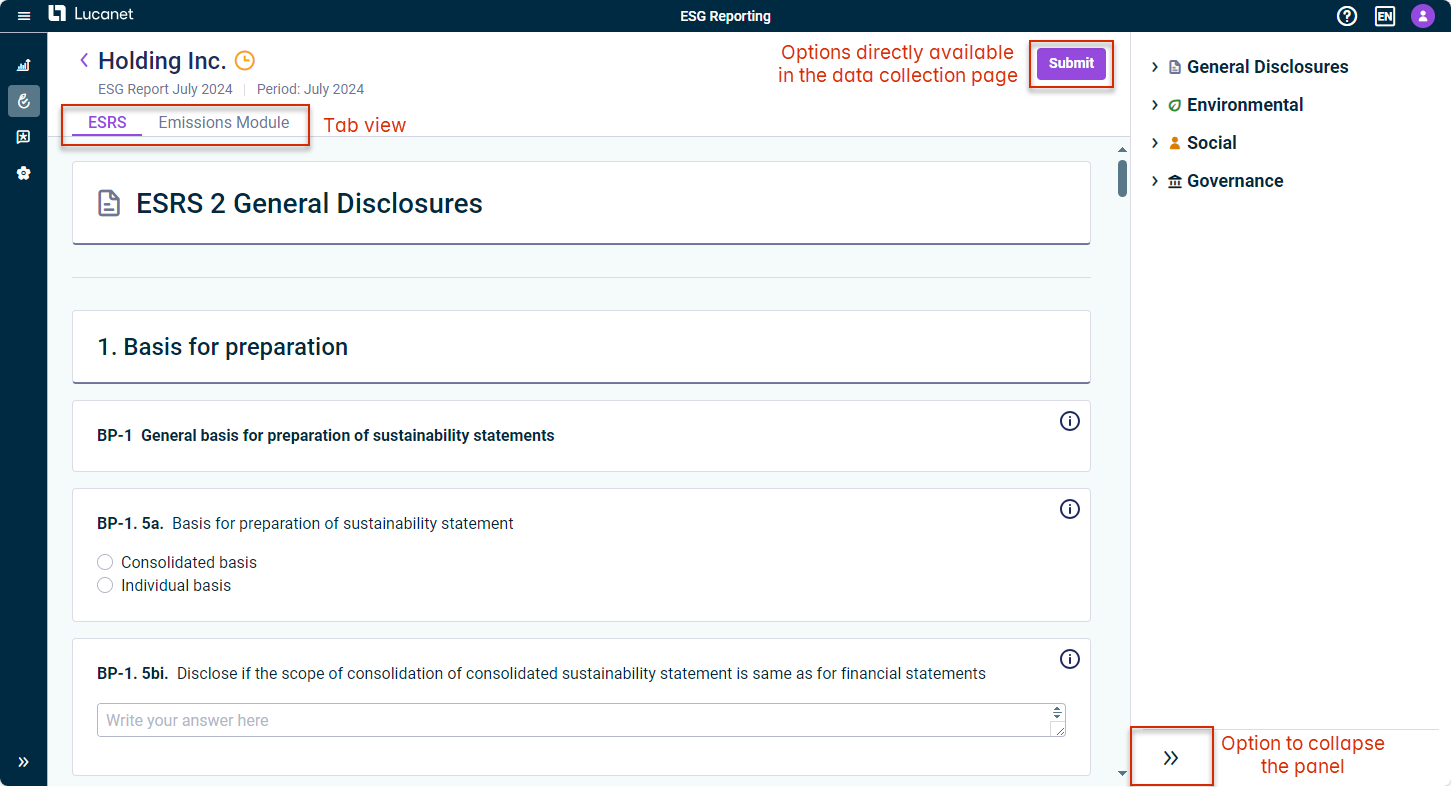 New functionalities for the data collection
New functionalities for the data collection
For more information, see
- General Functions in ESG Reporting for an overview of all available options depending on the user role
- Collecting Data for the available options for ESG Data Collectors
- Checking Data for the available options for ESG Masters
Enhancements Regarding the Data Version of the Emission Factor
When creating a footprint, the system now automatically uses the latest data version of the emission factor for GHG calculation. The data version used is stored and displayed for every footprint:
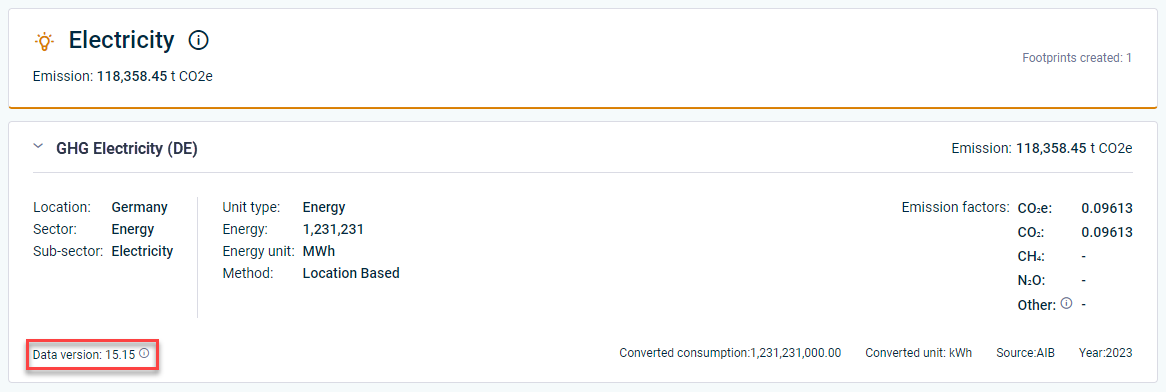 Data version displayed on a footprint
Data version displayed on a footprint
For more information, see Collecting Data.
Drill-down on Aggregated Data in Tables
An ESG master can drill down on aggregated data in the aggregated ESG report to display the underlying data that have been submitted by each reporting entity, such as text inputs, answers to multiple-choice questions, or currencies. As of now, it is also possible to drill down on aggregated data displayed in tables to view the data entries of individual reporting entities.
 Drill-down to data entered by individual reporting entities
Drill-down to data entered by individual reporting entities
For more information, see Aggregating Data.
Creating and Displaying Notes
As of now, a note can be added in the confirmation dialog for certain actions:
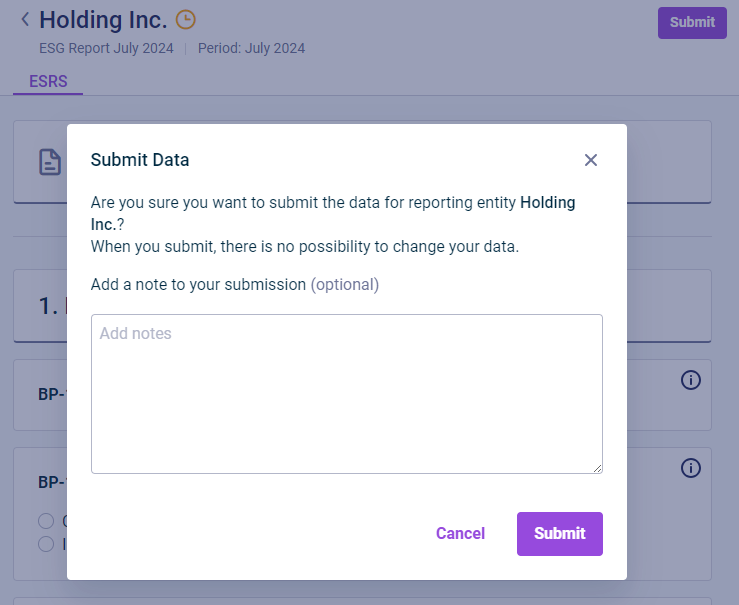 Creating a note
Creating a note
A note can be added to the following actions:
- The submission of a report by the ESG data collector
- The approval of a report by the ESG master
- The rejection of a report by the ESG master
As soon as a note has been created for an action, the note can be displayed on the data collection page by clicking the three-dot-icon and then Show notes:
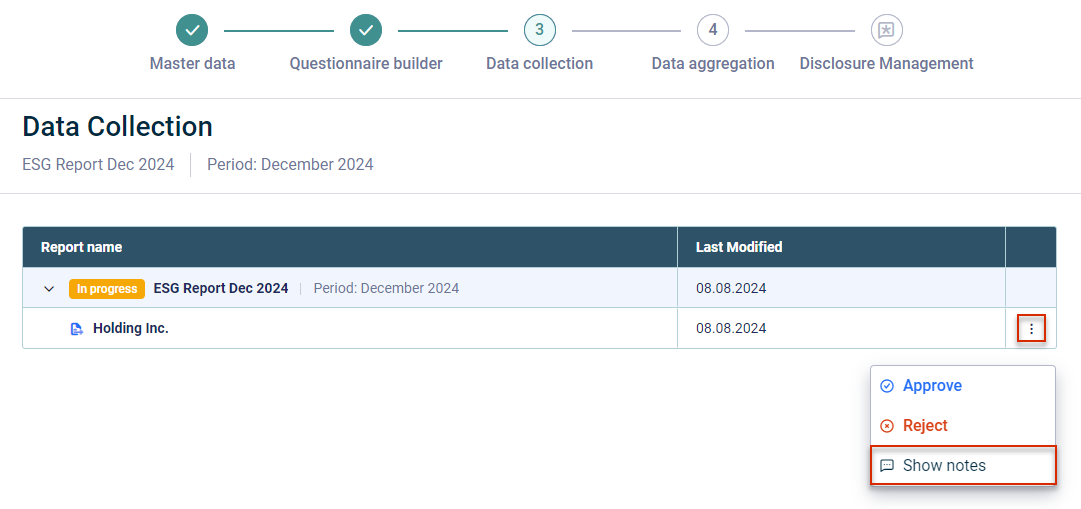 Opening a note
Opening a note
You can also display the notes on the data collection page of a specific reporting entity directly in the panel on the right-hand side. For more information, see General Functions in ESG Reporting.
New in Version 1.4 (Release Date 2024-11-05)
Import of MS Excel File Data into Reporting Entities
Data from MS Excel can now be imported via the Lucanet CFO Solution Platform using the new workspace Importing Data into Reporting Entities. This new feature reduces time and effort, since, previously, it was only possible to import data into reporting entities via Lucanet.Financial Client.
This Lucanet CFO Solution Platform feature provides the well-known functionality of importing data from MS Excel while also providing an enhanced UI.
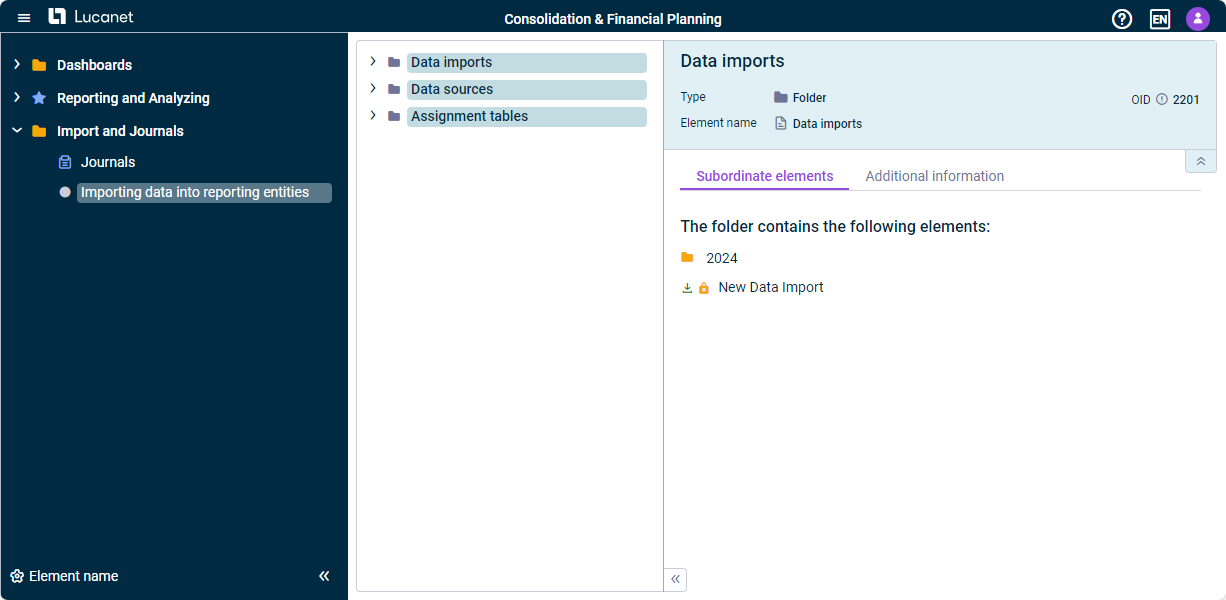 The 'Importing Data into Reporting Entities' workspace
The 'Importing Data into Reporting Entities' workspace
Changes to the Menu
Unified workspace for an improved overview: The functional area Journals is renamed to Import and Journals and will contain, additionally to the Journals workspace, the newly added workspace Importing Data into Reporting Entities.
UX and Usability Improvements
A number of improvements have been implemented for the overall user experience and usability. Some of the most prominent improvements are:
- Labeled tabs: The browser tabs in the Lucanet CFO Solution Platform are now labeled with a title naming the opened workspace, ledger, or solution, allowing for better navigation and management of the browser session.
- Enhanced view of long texts and elements: If the name of an element is too long to be shown, a tooltip with the complete name will be displayed when hovering over the element.
New in Version 1.0.937 (Release Date 2025-01-08)
Copilot in Word Documents
A Copilot with two AI-supported functions is now available in the Word ribbon for Disclosure Management to assist you in creating reports. Both functions can significantly enhance the quality of your texts and considerably reduce the effort required for text creation.
- Optimizing texts in Word documents
With the following functions, you can optimize your texts in no time:- Change the tone of voice e.g. to positive, neutral, or formal and precise
- Shorten or expand the text
- Summarize content into bullet points
- Create concise headlines
- Enrich sections of the document with specific information
- Draft taxonomy-compliant texts
Another new AI-powered function helps to you efficiently and precisely create taxonomy-compliant reports by automatically generating texts for any disclosure label from the ESRS (European Sustainability Reporting Standards) or IFRS (International Financial Reporting Standards) standards.
For the selected disclosure label, you can provide additional company-specific information in a text field. The new function then automatically generates taxonomy-compliant text sections, incorporating the additional company-specific information into the generated text, if provided.
If you do not provide any additional information, template texts will be generated based on the requirements of the respective taxonomy. You then only need to add the company-specific facts to these template texts. During generation, the report language and document layout are automatically implemented.
The Copilot for Disclosure Management is also characterized by the following features:
- Disclosure Management automatically generates the required prompts - you don't have to worry about anything else.
- Discard unwanted results or try again until you are satisfied.
- If you accept the result, it will be seamlessly inserted into your document.
Inserting an ESG Table Easily and Conveniently
Disclosure Management now includes two new time-saving functions for inserting ESG tables into an Excel spreadsheet:
Automatic Column Assignments
When inserting an ESG table into an Excel table in Disclosure Management you now have the option to specify whether the programming columns and value columns should be assigned automatically or not. When using automatic assignment, you can also assign periods to the columns in the table before the insertion.
When you click Insert, the table is inserted in MS Excel. The inserted columns are also configured as follows:
- The first column is added as the name column.
- The columns in the table are used as value columns for the specified period.
- The programming columns are inserted into the table on the right.
Automatic Increase of Row Count
When a dynamic table is selected in the Insert table window, you now have the option of automatically extending the table by a certain number of rows. You can use this option, for example, to have placeholders for additional data in the Excel table so that you do not have to manually expand the table later.
Revision and Optimization of the Design of the Connections
The design of the connection details in Import Management has been revised and optimized.
Saving Office Templates and Layout Robots
You can now save the Office templates and layout robot locally. This allows you to easily upload and use the templates and the layout robot in another report at any time. The download function is available in the settings for a document under Configure document.
Exporting a Chapter Structure of a Document
You can now export the chapter structure of a document from the cockpit to an Excel file at the click of a mouse. You may choose to do this when you want to discuss the structure of the document with someone who does not have access to Lucanet Disclosure Management, for example.
New in Version 1.0.862 (Release Date 2024-11-07)
Transferring Tables and Texts from ESG Reports
From now on, tables and texts from the questionnaire of aggregated ESG reports created with the solution Lucanet ESG Reporting can be inserted directly into documents in Lucanet Disclosure Management. As a result, no new report tables have to be created or new report texts compiled. They can simply be transferred with a few clicks instead.
The new feature is configured using the Excel ribbon (for tables) and the Word ribbon (for text values):
Adding Footnotes
From now on, it is possible to add footnotes to the Oareas of Excel files. For this purpose, footnote columns can be defined using either the Excel ribbon or the context menu. The footnotes stored there are then displayed in the Word documents in the Outareas and can be edited in the data view by means of the detail view for a value.
Adding Column Names
A column name can now be assigned to cells in MS Excel to distinguish between different value columns within a period in the data view. The column names can be added in MS Excel using either the Excel ribbon or the context menu of a cell.
Import into Selected Periods of a Data Source
When configuring the execution of an import in the Import data area, periods previously defined in the data source can now be excluded from the import. For this purpose, the No import option must be chosen for the periods in which data is not to be imported only during the parameterization process.
With this option, data can be imported only in selected periods of a data source without having to define a new data source for this purpose.
New Features in the Data View
Improved User Interface
The user interface of the data view has been revised. A uniform design and new icons and identifiers make it easier to use the individual features.
Data View Legend
A legend is now available for the data view. It can be opened with a button on the user interface of the data view. The cell colors, highlighting, marking, and validation icons used in the data view are explained in the legend:
Detail View for Text Values
A detail view is now available in the data view also for cells that contain text values. This allows, for example, the history of a text value to be displayed and past text values restored.
Link to Referenced or Validated Values
If a value referenced from a different Excel document is displayed in the data view, the data view of the Excel document from which the value comes will now be able to be opened and the value edited directly there by clicking the reference icon.
If a value for which a validation has been configured is displayed in the data view, the data view of the Excel document to be used for the validation will now be able to be opened by clicking the validation icon. This allows faulty validations to be checked more quickly and the underlying values corrected if necessary.

